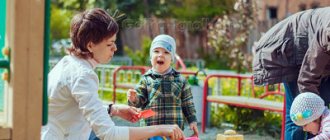“...in a community, under guidance, with help, a child can always do more and solve the most difficult problems than on his own.” A.V. Zaporozhets, famous Russian psychologist.
I want to draw the attention of parents to a very important period of the baby’s development, which we call “pre-speech”. It is during this period that the baby prepares for further speech development, which is not yet noticeable, but is already very actively happening. From my many years of experience, I know that many mothers pay little attention to the baby’s humming and babbling; many do not even know what it is and how they differ.
But the first symptoms of trouble can manifest themselves precisely during this period, when the child’s nervous system is still very plastic and susceptible to therapeutic influence. You should also not make preliminary diagnoses, because we are adults too, very different. Some are talkative, some are called “silent”, one cannot live without communication, while the other likes to be alone. And our children are like us, of course. Along with the norm, I give examples that, in combination with other symptoms, should alert parents.
Often there is nothing serious behind these symptoms, just a minor correction is needed. Mothers come to see me with completely healthy children who had babbling and humming features. Yes, not everyone who had deviations in pre-speech development later developed problems with speech and reading; very often everything returned to normal. But all children with speech difficulties necessarily had disorders of early speech and pre-speech development.
Stages of pre-speech development
- The first year of life is called the period of pre-speech development, during which preparation for mastering speech occurs. From the very first day of life, the child prepares for speech. Already from the moment of birth there are vocal reactions - screaming and crying. With these signals, the baby communicates that he feels bad, is hungry, and is sick. A healthy newborn makes individual sounds between “a” and “e”.
- You should pay attention if the baby sobs when sighing, with a characteristic nasal tint, or if there is a piercing, painful, continuous cry, which is usually called “brain”. If these symptoms do not go away, you should consult a specialist.
- Gradually, the child learns to listen to his own speech and the speech of others. From the 1st month, the baby calms down when he hears a lullaby. Increased interest in human speech in the form of a concentration reaction appears at 4 - 5 weeks. When an adult leans over a child and talks to him tenderly, he stops crying and moving and “listens.” At 5-8 weeks, the child smiles in response to the speech of an adult, from 8 weeks - a real smile, by 9-12 weeks laughter appears. Starting from 6-8 weeks, in response to an adult’s attempt to make contact, the baby makes individual sounds - hooting (initial humming). True humming or melodious humming appears in the 2-3rd month. The child, being in a calm state, makes drawn-out vowel sounds.
- With certain pathologies of the nervous system, a child may not show interest in an adult’s speech and may not respond to surrounding objects. In children in such cases, negative reactions usually predominate (monotonous crying, prolonged screaming in one tone), smiling is extremely rare, and there is no humming.
- By 5-6 months, the nature of the sounds becomes more complex. Combinations appear: “baaa, maaa”, “taaa, paaa”. Observing a child, one can note that at the moment of pronouncing sounds, he slows down his vocal movements, as if listening and imitating himself, pronounces sounds in the form of chains. By about the 5th month of life, sound and syllable pronunciation begin to acquire some semblance of words. By 5-6 months, the humming gradually turns into clear and distinct speech sounds, and babbling speech appears. The first babble consists of short chains of syllables: ba-ba-ba, ma-ma-ma. Parents sometimes mistake such babbling strings for meaningful speech, but these, of course, are not words yet.
- Children with a lack of humming, low expressiveness of speech, and lack of imitation deserve special observation. A child with initial signs of early childhood autism may be clearly non-communicative, passive, indicative reactions will be reduced or, conversely, motor activity, anxiety, negative emotional reactions to new objects (crying, screaming) will predominate.
- By 9 months, babbling is enriched with new sounds, intonations, and develops into long rows of syllables. Babbling becomes a constant response to an adult’s voice and accompanies various actions with objects and toys. At 9 months, the child demonstrates understanding of speech addressed to him, reacts to his name, perceives some simple verbal instructions and responds to them with action: “open your mouth”, “give me a pen”, presses his cheek to his mother when asked “kiss mom”, raises his head and their eyes turn to the lamp when asked “where is the light?”, they look for a toy hidden in front of their eyes, when they hear the word “no” they stop reaching for any object, or stop pulling it into their mouth, etc. Children aged 9-10 months are characterized by active babbling, consisting of 4 - 5 syllables or more. The child repeats new syllables after the adult, which he himself has not previously uttered, and copies intonation well, accompanying it with expressive facial expressions and gestures. By 9-10 months, he pronounces individual words consisting of identical paired syllables (mom, dad).
- A child of 11-12 months increasingly pays attention to the face of the speaker, begins to nod his head as a sign of approval and shake it as a sign of denial. The syllables included in babbling become components of words: ma-ma-ma - “mother”. The baby begins to designate certain objects with sound combinations, for example: car - “beep”, etc. At the same time, children of this age usually develop a new interest - looking at books with pictures. Recognizing familiar objects in pictures or showing them at the request of an adult, children designate them with babbling words.
- By the age of one year, the dictionary usually reaches 8-10, and sometimes more, “words” (baba, kisa, mu, be, etc.) that have a specific meaning. By the age of 1, the child understands and follows 5-10 simple instructions: “bring this,” “close the door,” “give me a cup,” etc. Thus, in the first year of life, the child’s speech apparatus is preparing to pronounce sounds. At the same time, there is an active process of developing speech understanding.
Age from 1 year to 2 years
Despite the fact that expressive speech begins to actively form during this period, the most important indicator of speech development is the understanding of addressed speech. Passive vocabulary at this age significantly exceeds active one. Children speak individual words denoting objects or actions, and by two years of age, two-word phrases appear. My vocabulary is growing rapidly. Speech is emotionally charged, accompanied by facial expressions and gestures. Sound pronunciation at this age is still largely unformed. In the vocabulary of a one and a half to two year old child, nouns (names, names of objects, animals) predominate; verbs (give, go) and adjectives (big-small) begin to appear. By the end of the second year, the child should use simple phrases, speech becomes the main means of communication.
What should mom do?
By “infecting” the baby with positive emotions, the mother stimulates his interest in the outside world, and since the satisfaction of this interest involves the expenditure of physiological resources, she stimulates in a certain direction both metabolic processes and tissue differentiation in the body of her baby. On the contrary, by transmitting negative emotions to the baby, we suppress not only his interest in the outside world, but also certain biological processes of his body. It is no better when the adults around the child “infect” him with too strong affective emotions.
These energy-intensive emotions deplete the child’s nervous system and can lead to somatic diseases. An adult’s mechanical fulfillment of routine tasks, his indifferent, indifferent attitude towards a small child excludes the possibility of any kind of emotional contact at all. With such an adult, the child does not have the need to communicate, and therefore does not develop cognitive experience and does not form the necessary communicative-cognitive means. There is a threat of delayed mental development and disruption of the child’s further interaction with adults. The child’s brain develops incorrectly or is delayed in the absence or deficiency of external stimuli.
And, vice versa: interest in an adult, curiosity about the outside world and communicative-cognitive activity are caused and supported, as we have seen, by positive emotions emanating from an adult. Therefore, we can repeat once again that for infancy, the emotional communication of a child with an adult is not a luxury, but a primary necessity, a condition for the formation of his psyche according to the human social type. Depriving an infant of the emotional attention of an adult at this early age leads primarily to abnormal development of the child’s personality.
If parents notice trouble, and this is not one symptom, but several (lack of babbling, humming, change in voice, behavior), then you should contact a specialist. And then, along with speech therapy correction (massage, articulation gymnastics, stimulation of vocal reactions), drug treatment, physiotherapy, etc. are prescribed.
Age from 5 to 7 years
A child’s active vocabulary at this age is very wide. A child can name 5-6 or more characteristics of one object (the river is wide, cold, blue, deep, beautiful). By the age of six, children learn the basic patterns of changing words and combining them in a sentence. When forming a phrase, all the main parts of speech are used. Normally, by the age of six, a child masters all the sounds of his native language and uses them correctly in speech. In a child’s speech, as a rule, there are no omissions or rearrangements of syllables and sounds. The only exceptions are certain difficult and unfamiliar words (“excavator”). The development of contextual speech is manifested by the ability to retell fairy tales, stories, and one’s own impressions.
Dear parents! Remember that timely and complete mastery of speech is the first most important condition for the formation (appearance) of a full-fledged psyche in a child and its further correct development.
How to stimulate speech development
The sooner trouble is noticed in the development of a child’s speech and the sooner specialists begin working with him, the better the results achieved will be: the reserve capabilities of the brain are especially high at an early age, during the period when speech is actively developing.
At the stage of pre-speech development (1-3 months), it is necessary to stimulate motor and communicative functions, develop and consolidate the child’s need to communicate with adults, strengthen the ability to fix gaze and follow a moving object. Gradually move on to active stimulation of fine motor skills. If there is no humming or impaired vocal reactions at this stage, the doctor may prescribe, along with drug therapy, speech therapy correction (facial massage, breathing and articulation exercises). At the 3rd stage of pre-speech development (3-6 months), the baby manipulates toys, pulls them into his mouth, rolls over and crawls towards an object that interests him, throws toys and follows their movement. In cases where there is a delay in pre-speech skills, it is advisable to carry out their targeted stimulation. For example, create situations that cause the child to laugh, roar, as imitation reactions. If necessary, speech therapy correction may consist of active speech therapy massage and activities aimed at developing babbling. At the 4th stage (6-9 months) and the 5th stage (9-12 months), the possibilities of speech therapy assistance expand.
Along with active massage and gymnastics, they begin to stimulate tongue movements, chewing movements, and lip movements. Stimulate the ability to recognize the intonation coloring of spoken speech. Stimulation of babbling and initial syllable formation is carried out with the help of appropriate imitative or imitative games (“Ladushki”, “Goodbye”, “The geese flew - they sat on their heads..”, etc.) The effectiveness of speech therapy correction of pre-speech disorders cannot be carried out without active stimulation of mental development. After 6 months, the child is stimulated to perform purposeful actions with various objects, stimulate repeated actions, and meaningfully communicate with adults. From the second half of a child’s life, they are taught to handle and manipulate objects.
Ages 3 to 4 years
Children talk a lot and use phrases of 3-4 words in their speech. The order of words in a sentence or their agreement may still be disrupted. At this age, the child names his first name, last name, and gender. Determines color, shape, texture, taste, using definition words. Distinguishes and names toys, pieces of furniture, clothing, dishes, food, and animal body parts. Tells about what he saw in 2-4 sentences. Listens to long tales and stories. Follows a two-part instruction (“Give me a big bear and a red ball”). Normally, children of this age still have deficiencies in the pronunciation of a number of words, especially long and unfamiliar ones.
Sound pronunciation
- The pronunciation side of a child’s speech can be judged only when he has accumulated a significant vocabulary. The time and order in which sounds appear varies from child to child. In the third year of life, a child has the right to incorrect sound pronunciation. Thus, he usually skips or replaces whistling sounds (S, Z, Z', Ts), hissing (Sh, Zh, Ch, Shch) and sonorant sounds (R, R', L) (S-S'; Z-S' , V; C-T'; Sh-S', T'; Zh-S', D'; Ch-T'; Shch-T'; R-L'; R'-L'; L-L')
- If any violations of the pronunciation aspect of speech are detected in infants, timely corrective measures and additional examinations by other specialists are required. The prospects for mental development, the success of education of children with disabilities in neuropsychic development, their school and social adaptation depend on the early detection of disorders in cognitive activity. But often speech therapists at the clinic advise you to wait a little - “don’t come before 5 years.” This can be explained by the fact that working with a child requires a special individual approach, and not every specialist has the necessary knowledge, experience, and most importantly, the desire to work with young children. But a good speech therapist will not brush off worried parents.
- If a child aged 1.5-3 years does not have active speech, it is necessary to arrange an appointment for a consultation with competent specialists: a neurologist, psychologist, speech therapist, otorhinolaryngologist, and conduct a series of diagnostic studies. Parents should be concerned about speech delays not only when the child has no speech at two years old, but also in cases where development is delayed or there is a complete absence of humming and babbling. Observations by specialists and objective data from medical research will make it possible to clarify the nature of the disorder, the degree of its complexity, suggest possible causes and organize adequate assistance for the child.
- At any age, speech impairments limit cognitive activity and the possibilities of social adaptation of a person. Consultations with competent specialists and correctional classes with speech pathologists and speech pathologists will help distinguish speech disorders from other disorders (mental retardation, mental retardation, hearing impairment, autism spectrum disorders) and make a more accurate diagnosis. Early correction and systematic speech therapy sessions, which are essentially a well-organized game, can completely compensate for a speech defect.
- The importance of speech development at an early age is great: speech, along with intelligence, is an important indicator of a child’s development, and its violations are evidence of trouble in the mental sphere. Speech reflects the success (or failure) of mastering the native language - the main social acquisition of the child during this period.
- The speech of a young child reflects the development and lays the foundations for future higher mental functions: memory, attention, thinking, and therefore all further education of the child, and ultimately his social adaptation and success. That is why in correctional and developmental work with young children, special attention is paid to the stimulation (formation) of speech activity.
Age 4 to 5 years
The child knows and uses many nouns, verbs, adjectives in speech, uses generalizing words, names animals and their cubs, people’s professions, and selects antonym words. The ability to form words develops. With the help of adults, a child can retell a familiar fairy tale. In their statements, children begin to use the structure of compound and complex sentences. By the age of five, almost all age-related irregularities in pronunciation disappear. The sounds L and R may remain unformed.
About organizing classes
The development of a child’s speech occurs at every moment of his life. Everyday situations, including getting ready for bed, washing, eating, take place under almost the same conditions. This helps enrich children's vocabulary and strengthen their speech skills. Contacting children for various reasons creates their need for communication. At the same time, it is necessary to more actively use play and everyday situations that are pleasant for the child. For example, when washing or bathing a child, you can hum a composed song as you go, drawing the baby’s attention to the parts of the body and face about which it is sung, with a gentle touch:
- Where, where, where, where, where are our hands? (2 times)
- Here they are, here they are, here are our hands. (2 times)
- Where, where, where, where, where are our legs? (2 times)
- Here they are, here they are, here are our legs. (2 times)
- Where, where, where, where, where is our tummy? (2 times)
- Here it is, here it is, here is our tummy. (2 times)
- Where, where, where, where, where are our eyes? (2 times)
- Here they are, here they are, here are our eyes. (2 times)
- Where, where, where, where, where are our cheeks? (2 times)
- Here they are, here they are, here are our cheeks. (2 times)
The mother's affectionate voice and pleasant stroking movements will stimulate the child's independent vocal reactions.
Just communicating with your baby in everyday life is not enough for his development. It is necessary to use speech in objective and play activities. It is also advisable to conduct specially organized classes (games and activities). It is important to consider that at an early age, all tasks given to the child should be offered as an entertaining and interesting game. Only against a positive emotional background will the baby himself want to say a new word, repeat a combination of sounds or a phrase he heard.
When learning new words, you should always use a toy or object first and then a picture. If the child easily recognizes and names familiar objects and toys, you should gradually move on to working with subject and plot pictures.
Speech therapist, neurodefectologist Elena Gennadievna Timoschenko, author of the Territory of Health series of lectures “Early development of speech and intelligence of a child.”
Age 2 to 3 years
Children's vocabulary is expanding rapidly. The child uses verbs and adjectives more widely and begins to use pronouns and prepositions. Using adjectives, he not only denotes the sizes of objects, but also names their colors, qualities, properties, shape (red, bad, hot, round). Normally, children of this age still have constant errors in gender, number and case of nouns; they do not always use conjunctions and prepositions. The pronunciation of words becomes more accurate, and although many words are pronounced distorted, the child’s speech is quite understandable to others.








